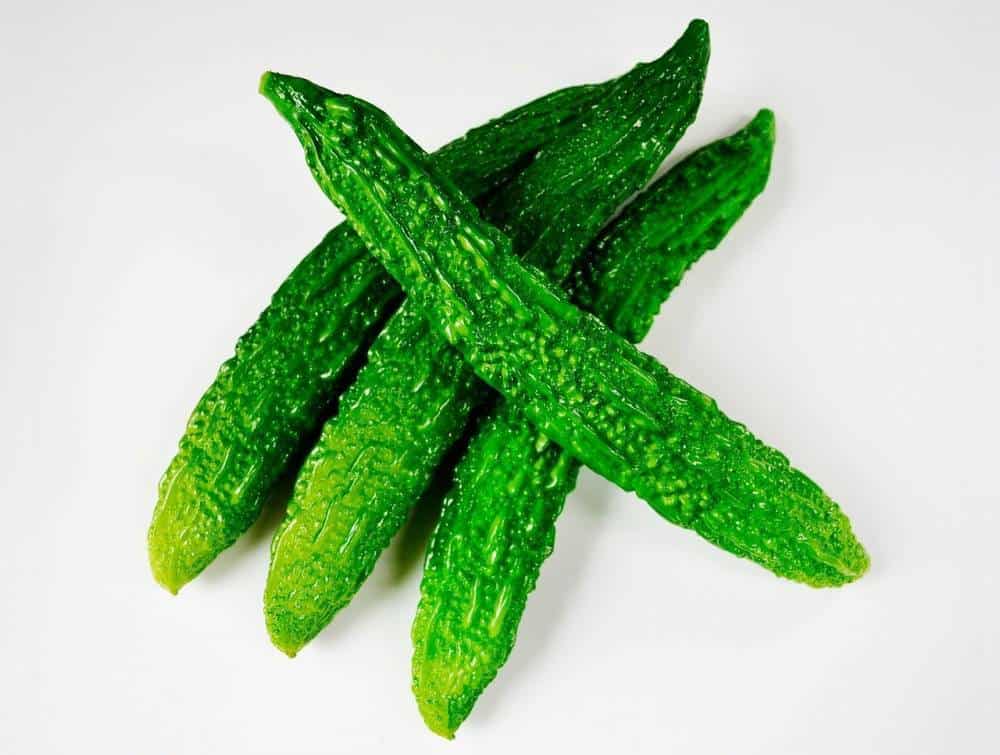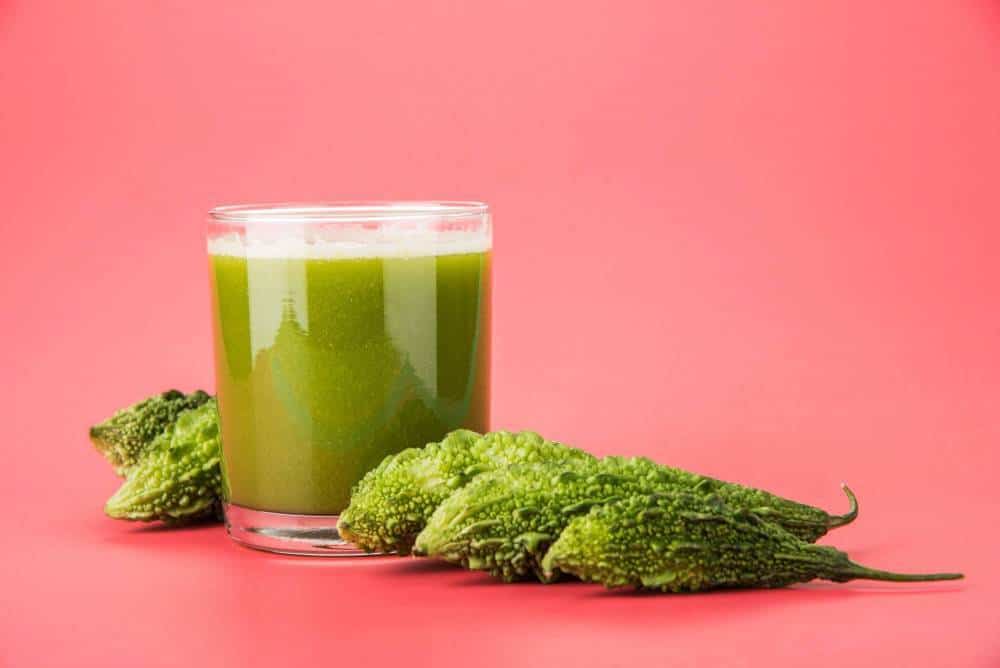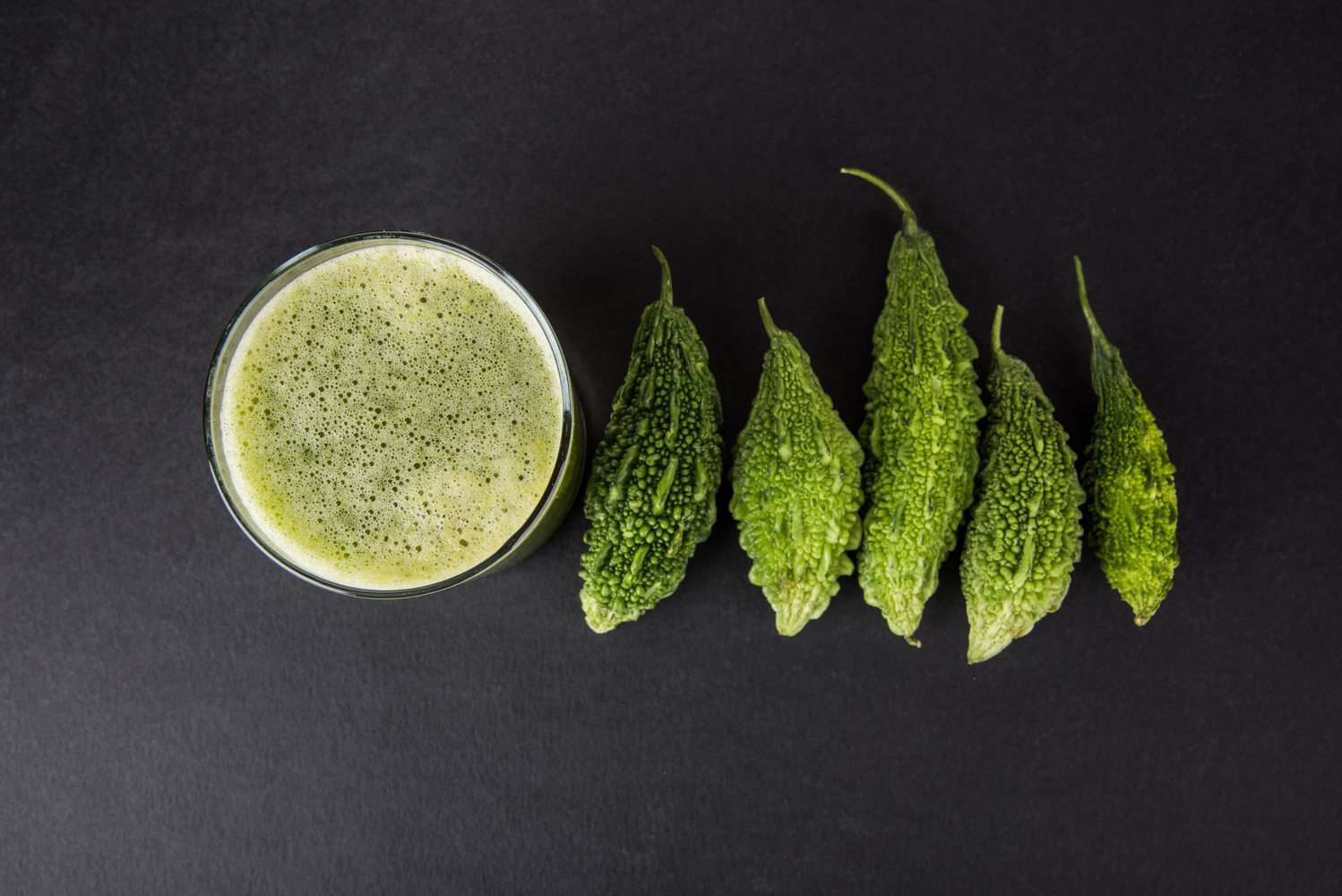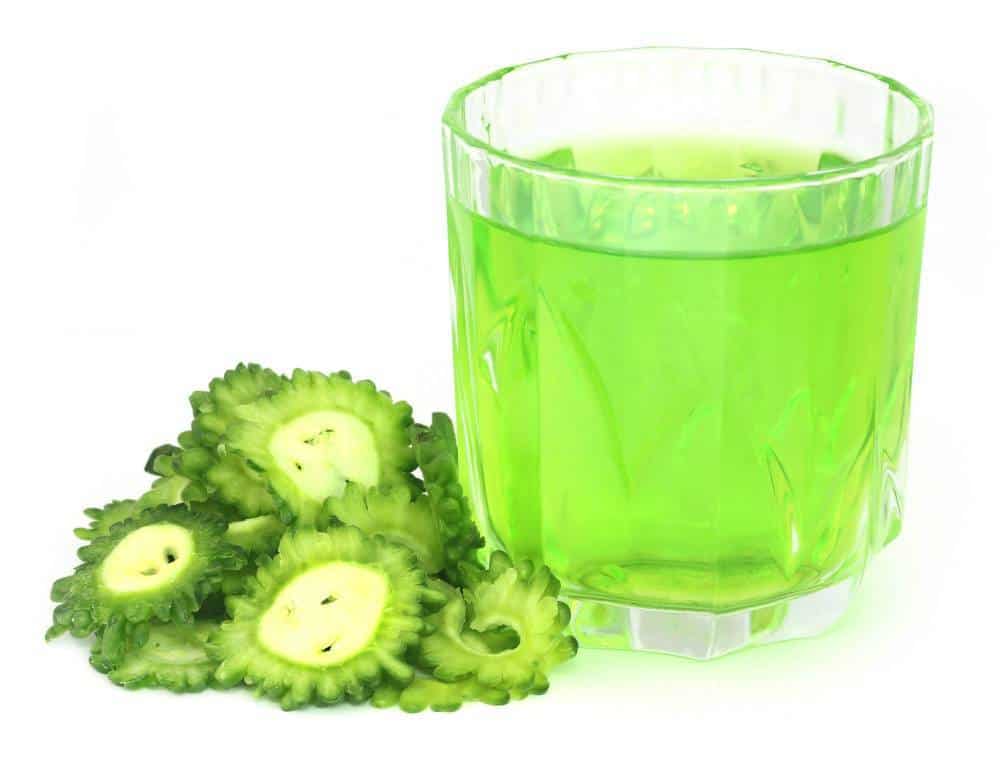
The juicing trend has come a long ways since Jack LaLanne first introduced the Power Juicer to the world in an infomercial. It was then that the idea reached the masses – juicing fruit and veg is a quick route to a healthier diet, and life.
Today, it’s not uncommon for the average Joe to have a $150 juicer in his kitchen. People are willing to shell out big bucks for a glass of fresh juice at a juice stand. It’s commonplace. We find ourselves looking for somehting a bit more interesting than boring old apples, oranges and berries.
The health and nutrition blogosphere is full of never before heard of fruits being touted for their incredible health benefits. Making waves presently is the karela fruit. Have you ever heard of it? I sure hadn’t. As it turns out, the karela juice benefits are quite impressive. We’ll dig a little deeper into what it may be able to do for your health.
What is Karela Juice?
Karela – the scientific name of which is momordica charantia – is technically classified as a fruit. You may also hear it referred to as bitter melon, bitter gourd, carilla fruit, African cucumber, bitter cucumber, and a few others. That’s an awful lot of names for one fruit, huh? To avoid confusion, I’ll just refer to it as “karela” from now on.

The karela plant is cultivated throughout India, Africa, and the Caribbean mostly to harvest the bitter fruit. While some of the other parts of the plant are used in traditional Eastern medicines, the medicinal and culinary prize lies in in the unripe fruit.
Karela is typically consumed unripe. It is a widely used ingredient in many types of ethnic cuisine – you’ll find it in everything, from stir fry to curry to soups.Karela is very bitter in its typical unripe presentation – as you’ve probably guessed from all its bitter monikers.
The extreme taste is the most likely reason why the fruit hasn’t become a supermarket staple here in the United States. However, when you hear about its powerful medicinal properties, it might just convince you to choke it down!
What Does a Karela Fruit Look Like?
There are a few different varieties of karela which vary in appearance. In general, they look most similar to a cucumber. The most common Chinese cultivar is like a large cucumber (up to a foot long!) with a lighter green flesh and wavy skin rather than smooth.

Another common variety from India is more football-shaped. Its skin filled with ridges and furrows. It looks sort of like a cucumber that’s been inside a dehydrator for a few days!
The inside flesh of both varieties above about starts out white and turns bright red as the fruit ripens. At this point, it also becomes very sweet and tastes unpalatable.
Karela Juice Benefits for Health
When you look at the simple nutritional facts of karela fruit (and juice), it certainly doesn’t seem like anything special. It’s mostly sugar, water, with mostly trace amounts of vital vitamins and minerals.
Though high in vitamin C and potassium, and low in calories, the real power lies in the phytonutrient (plant chemical) compounds present. These phytonutrients include carotenoids, momordin, charadin, and vicine.
Karela juice is used frequently in various traditional Asian, Indian, and Middle Eastern schools of medicine. The purported medicinal benefits of this fruit juice are vast according to traditional medical practitioners.

As we discuss some of these potential benefits, it’s important to note that, when it comes to bitter melon, studies have not conclusively proven its efficacy for the treatment of any diseases or medical conditions. Since karela juice is generally safe (barring a few conditions we’ll discuss later), it’s fine to give it a try and see for yourself.
As long as you’re drinking the juice within reason and speaking to your doctor about all supplements and medicinal food you’re taking in, it shouldn’t cause an issue.
1. Type 2 Diabetes
Type 2 diabetes is a condition that causes the body cannot produce enough insulin or becomes unable to respond to it. Insulin vital for processing carbohydrates. When insulin is in short supply, you’re left with high blood glucose levels, which cause a multitude of problems.
The effect of Karela juice on diabetic patients is one of the only studied uses of the substance in Western medicine. Scientists have isolated compounds in karela that seem to aid in the treatment of diabetes. These compounds have the power to activate the enzyme AMPK, a protein also activated by exercise. AMPK helps the body process glucose.

Pharmaceutical drugs currently used to treat diabetes also activate AMPK, so karela juice has potential. Unfortunately, research is only in the early states so doctors are highly unlikely suggest that their patients forego diabetes medication and begin using only karela juice. It’s certainly worth keeping an eye on, however.
2. Cancer
Cancer is a disease that causes abnormal cell growth. It can occur in any part of the body and has been found to effect most types of cells. It is notoriously difficult to treat and many of the current treatment options come with horrendous side effects.
In a study performed at the University of Colorado, bitter melon juice was found to prevent pancreatic cancer cells from metabolizing glucose. The cancer cells then died. This is a rather incredible result, since scientists have been working on synthesizing drugs to stop cancer cells from gaining energy in this way.
Preliminary findings in another study showed that karela juice was effective in fighting head and neck cancers. Tumor growth in this study was halted or even reversed. I expect to see a lot more research in this area over the coming years as results are very promising.
3. HIV/AIDS
I’m sure you know that HIV (human immunodeficiency virus) is a serious illness that affects the immune system. It is a precursor to AIDS (acquired immune deficiency syndrome). The HIV virus is transmitted through bodily fluids. This virus damages the immune system, resulting in vulnerability to a number of other health problems.

Tests have shown that karela may help treat HIV. Some of the phytonutrient (plant chemical) compounds in the fruit have been isolated and have shown in lab tests to be effective in fighting the HIV virus.
Controlled experiments that prove without a doubt that karela can act as a treatment for HIV/AIDS are lacking. The treatment is still experimental, but since the side effects of karela are few and far between, there are certainly patients out there willing to give it a shot.
4. Liver Disease
Some lab tests have been indicative of karela juice’s positive effects on liver health. The studies showed that the juice was able to boost antioxidant activity in the liver to help protect the organ from damage.
One study, which appeared in the January 2009 edition of the ‘International Journal for Vitamin and Nutrition Research’ showed these effects carried over from in vitro (test tube) tests to lab rats. Though human studies haven’t been carried out yet, the benefits may outweigh the risks for this natural remedy.
5. Psoriasis
Psoriasis is a disease that causes scaly, red patches to appear on the skin. There are many types of psoriasis affecting approximately 7.5 million people in the USA alone. Research shows that this skin disease may be related in some way to an abnormality in the immune system. Modern treatments are not always very effective and can have many side effects.

One study showed that karela juice was able to inhibit the guanylate cyclase enzyme. This enzyme is partially responsible for the development of psoriasis. Though the end result of this claim needs to be studied further, karela juice may be a promising natural solution for those who suffer from psoriasis.
6. Stomach Troubles
Karela juice has long been used in traditional Indian and Eastern medicines as a remedy for stomach complaints. The whole fruit and juice have been used to heal stomach ache, flatulence, indigestion, and constipation. The effect is supposedly because karela “induces digestion”. Whether these claims are legitimate has not been tested.
Karela is also an emetic, meaning that it can cause vomiting. This is useful in cases such as ingestion of poision. Since side effects of karela include diarrhea and stomach ache, I wouldn’t use this juice as my go-to home remedy when it comes to stomach issues.
7. Increases Metabolism
Studies to determine karela juice’s ability to treat diabetes also showed that this substance may be involved in modulating your metabolic function. Whether this property can help people lose weight, as is the common assumption when we begin talking about increasing metabolism, is not proven.
8. Hangover
Though science hasn’t spent much time on this one, many people insist that karela juice is a great hangover remedy. If I had to guess, the purported liver and kidney support combined with the ability to help with stomach ailments are the main reasons karela juice is thought to help cure hangovers.

9. Kidney Stones
Karela is said to be useful in the prevention and treatment of kidney stones, though there is little evidence available to support these claims. Though karela likely doesn’t harm the kidneys in any way, it seems unlikely to help them, either.
10. Wounds or Abscesses of the Skin
Used topically, karela is used for wound care and abscesses in traditional medicine. Once again, the efficacy of these claims remains unproven by doctors and scientists.
How to Get Your Hands on Some Karela Juice
If you’re lucky, you may be able to find karela juice at your local health store. If not, why not ask them to stock it? It can also be found at specialty grocery stores. Check out your local Asian or Indian markets for both karela juice and the fruit itself.
You can also order karela juice online. A juice with no additives, preservatives, or chemicals is ideal for maximum health benefits. If karela juice is simply too bitter for you, it is also available in supplement form.
Selecting the Best Karela Fruit for Juicing
Don’t be shocked if you can’t find fresh karela at your store. Since this fruit is typically used when unripe, the transport and shelf storage required of produce that isn’t locally grown is not very practical. If your climate isn’t right, you’re probably out of luck.
If you can find fresh karela, it’s important look for a fruit that has a skin that is green or barely turning yellow. This indicates the fruit is still unripe as the skin turns yellow as it ripens. The fruit should be firm and feel crisp and watery – like a lumpy cucumber.
This video shows the karela fruit and how to make a juice from it:
Karela Juice Warnings
While generally considered safe, karela juice can have some harmful side effects. The ability to lower blood sugar means that it can cause hypoglycemia (low blood glucose levels). Hypoglycemia can be a dangerous condition – especially if you have diabetes. Karela juice may require diabetics to adjust medication dosages, so discuss with your doctor before trying it.
Karela juice should never be consumed by pregnant women. It has been known to cause uterine contractions and bleeding that could lead to early labor, hemorrhaging, and more complications. For safety’s sake, simply stay away from karela if you are pregnant.
As always, it is advisable to talk with your doctor about any dietary changes or supplements you’re taking. Karela in particular has effects on the body that your doctor should know about.
The Last Word on the Benefits of Karela Juice
Karela juice has not been studied in depth by Western medicine. As scientists realize its many capabilities, that’s likely to change. The potential benefits to people with cancer and diabetes – and without side effects – are sure to inspire more high quality studies and controlled trials in humans.
Do you have any questions about karela juice benefits or the safety of using this product? I’d love to hear about your experiences with karela juice!
Leave a comment